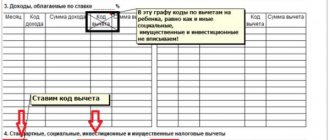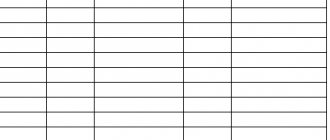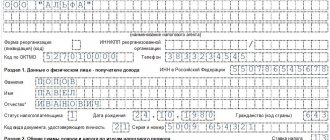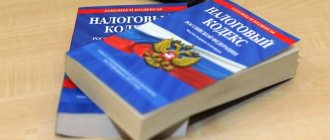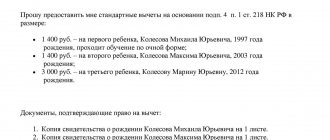In November 2011, the provisions of Federal Law No. 330-FZ of November 21, 2011 on changes to Part Two of the Tax Code of the Russian Federation came into force, in particular, on changes to standard deductions. A.V. talks about exactly how to apply an employee’s right to standard tax deductions in 2011 and 2012. Yarvelyan (SiData LLC, St. Petersburg).
Paragraph 3 of Article 210 of the Tax Code of the Russian Federation (hereinafter referred to as the Tax Code of the Russian Federation) determines the procedure for calculating the tax base for personal income tax for income for which a tax rate of 13% is provided, and introduces the concept of tax deductions. In accordance with this norm, the tax base is defined as the monetary expression of the specified income subject to taxation, reduced by the amount of tax deductions provided for in Articles 218-221 of the Tax Code of the Russian Federation.
In particular, Article 218 of the Tax Code of the Russian Federation defines standard tax deductions, which, in turn, in their meaning are divided into personal deductions and deductions for children. Personal deductions are provided to the taxpayer depending on whether he himself belongs to one of the categories specified in subparagraphs 1, 2 of paragraph 1 of Article 218 of the Tax Code of the Russian Federation. Deductions for children are provided to the taxpayer if there is a child in his care; the amount of the deduction depends on the conditions determined by the tax code in paragraph 3 of Article 218.
The deduction is provided only to an employee who is a tax resident of Russia, only upon his application and upon presentation of documents confirming his right to the deduction. Deductions are provided for each month of the tax period (i.e. year) in which the taxpayer had income taxed at a rate of 13%. Deductions for children are provided until the conditions specified for each type of deduction are met.
If a taxpayer works in several organizations, then the deduction can be provided to him only for one place of work of his choice.
If an employee had income taxed at a rate of 13% in at least one month of the tax period, then his income can be reduced by deductions for all those months of the current tax period when the right to deductions was not applied due to the lack of taxable income (letter from the Ministry of Finance Russia dated October 22, 2009 No. 03-04-06-01/269). If the employee did not have income taxed at the rate of 13% for a whole year (for example, a woman was on maternity leave), then deductions will not be applied for this tax period, and the employee will already take advantage of the right to them in the next tax period. can not. If an employee’s income for a tax period turns out to be less than the amount of deductions to which he is entitled, then the tax base for personal income tax is considered equal to zero, that is, earnings will not be subject to personal income tax (clause 3 of article 210 of the Tax Code of the Russian Federation).
If an employee did not get a job from the beginning of the year, then he must submit a certificate of income from his previous place of work so that all income and benefits applied since the beginning of the year are taken into account when making current calculations.
Deductions for children in 2011
Before the adoption of the commented amendments, the standard deduction for each child was 1,000 rubles. for every month. It did not matter how many children the taxpayer has and for which of them the deduction is provided.
Now the size of the “children’s” deduction depends on how the child was born. So, the deduction for the first and second child is 1000 rubles each. for each month, and for the third and subsequent children - 3,000 rubles. for each month (new edition of subparagraph 4 of paragraph 1 of Article 218 of the Tax Code of the Russian Federation).
This amendment came into force on November 22, 2011 (the date of official publication of the law under comment) and applies to legal relations that arose from January 1, 2011. This means that accountants will have to retroactively recalculate the personal income tax base for all employees who have three or more children. Moreover, you need to make the necessary adjustments when calculating salaries for November.
How should it?
How should the recalculation be made in 2011? Is it possible to recalculate deductions now? In 2011, employers had to recalculate personal income tax for that year for parents with many children and employees with disabled children. This could have been done as early as November.
When calculating personal income tax, the employer had to be guided by the provisions of paragraph 3 of Art. 226 of the Tax Code of the Russian Federation, according to which the calculation of tax amounts at a rate of 13% for tax residents is carried out by tax agents on an accrual basis from the beginning of the tax period based on the results of each month, with the offset
the tax amount
withheld in previous months
of the current tax period .
Then, when calculating wages for November or December 2011 and recalculating the amount of “children’s” deductions upward, the accountant actually had to withhold a smaller amount of personal income tax than he would have done without recalculating deductions.
If, at the end of the year, all of the excessively withheld personal income tax could not be offset, then the unoffset amount cannot be transferred to 2012. Starting in the new year, the tax agent will begin a new calculation of total income and tax. Therefore, the employer must return the “remaining” personal income tax to the employee.
To do this, it is necessary to notify him of the presence of an overpayment within 10 working days from the date of its discovery (clause 2 of Article 231 and clause 6 of Article 6.1 of the Tax Code of the Russian Federation), receive from the employee an application for the return of excessively withheld personal income tax for 2011 and only after To do this, transfer the “extra” personal income tax to the employee’s bank account.
This tax refund procedure is provided for in clause 1 of Art. 231 Tax Code of the Russian Federation. Example
An employee has three minor children, for whose support the tax agent provides him with standard tax deductions (the documents necessary for the deduction are available). His total income from January to December 2011 amounted to 175,000 rubles. An employee’s monthly income (salary) in January–November is 15,000 rubles. And in December – 10,000 rubles. The amount of personal income tax withheld from January to November 2011 is 17,056 rubles. When calculating salaries for December, the accountant calculated the amount of standard tax deductions for 2011 based on the new amounts. The amount of deductions amounted to 60,800 rubles: 60,000 rubles. for children ((1000 rubles (for the 1st) + 1000 rubles (for the 2nd) + 3000 rubles (for the 3rd)) x 12 months) and 800 rubles. on the employee himself). This means that for 2011 personal income tax should have been withheld from the employee in the amount of 14,846 rubles, which is 2,210 rubles. less than was withheld from January to November. Therefore, when paying wages for December, the employee received 10,000 rubles in hand, i.e., the previously withheld tax was offset against the December personal income tax. The excessively withheld 2,210 rubles. the employer will transfer based on the employee’s application to his bank account.
As representatives of the Ministry of Finance and the Federal Tax Service explain in their interviews, in order to recalculate deductions for 2011, it is necessary to receive two applications from the employee: the first - for the provision of deductions in 2011, indicating the new amount - 3,000 rubles, and the second - an application for recalculation of personal income tax from the beginning of 2011 year, taking into account new deductions. In our opinion, all this information can be reflected in one document.
If in December 2011 deductions for children and personal income tax amounts were not recalculated, recalculation can be done over the next three years (Article 78 of the Tax Code of the Russian Federation). And the excessively withheld personal income tax should be returned to the employee based on the application, as stated above. An employee can himself apply for a recalculation of deductions to his tax office by submitting a personal income tax return for 2011 and documents confirming the right to deduction (clause 4 of article 218 of the Tax Code of the Russian Federation).
Deductions for children in 2012 and beyond
Starting from January 1, 2012, the amount of “children’s” deductions will increase. For the first and second child it will be 1,400 rubles each. for each month, and for the third and each subsequent child - 3,000 rubles.
In what case is an increased deduction due for the third child?
The question arises whether a deduction of 3,000 rubles is due. in case the first two children (or one of them) are adults?
There are two opposing points of view.
Some experts believe that an increased deduction is possible only if the employee has two children, for each of whom a deduction of 1,000 rubles is currently provided. In other words, if the older children have not yet reached the age of 18 or are students (graduate students, interns, etc.) not older than 24 years.
Others argue that since there are no restrictions or additional conditions in the Tax Code, an “increased” deduction should be given for the third child, regardless of the age of the first two children. It is this interpretation that was confirmed by the Russian Ministry of Finance in letter dated December 8, 2011 No. 03-04-05/8-1014.
Accounting for personal income tax deductions in the program “1C: Salaries and Personnel Management 8”
The codes and amounts of standard deductions in the 1C: Salaries and Personnel Management 8 program were automatically changed when the information base was updated to release 2.5.42 (Fig. 1).
Rice. 1
However, updating the reference information does not automatically redefine employee deductions under the new rules. In order to apply innovations in the Tax Code of the Russian Federation when calculating personal income tax, it is necessary for all employees with two or more children to change the codes of applied deductions and the number of children.
In order to make it as easy as possible for an accountant to redefine employee deductions, an Assistant for editing deductions for children has been added to the configuration, starting with release 2.5.43.
This service allows each employee for whom the right to child deductions under the old rules was already registered before January 1, 2012, to change the deduction records so that they comply with the new rules. Commands for calling the Assistant are located on the Taxes tab of the Desktop, as well as in the Taxes and Contributions menu next to the command for entering property deductions.
When you select an organization in the service dialog box, all employees eligible for child deductions are automatically selected into the list. When you position the cursor on an employee from the list, the top table displays previously entered deduction entries, and the bottom table is intended to display edited entries that will be valid in 2012.
For each employee, depending on his individual situation, one of four automatic editing algorithms can be applied (Fig. 2).
Rice. 2
1. Do not replace deductions - this algorithm can be used for employees with one child. It, as the name suggests, does not make any changes to the deduction entries;
2. Leave deductions for the first and second children - this algorithm is intended for those employees who support two or more children, and everyone, including the eldest, gives him the right to a deduction. In this case, a deduction is allocated with code 114/108 (for the first child) - number of children 1, deduction with code 115 (for the second child) - number of children 1 and for all remaining children a deduction with code 116 is added (for the third and further children) ;
3. Leave a deduction only for the second child - this algorithm is intended for those parents whose eldest child has already grown up and a deduction is not provided for him. In this case, the previously used deduction with code 114/108 is terminated, but two new entries are created - for deduction with code 115 and the number of children 1 and for deduction with code 116 - for the remaining children
4. Replace with deductions for the third child - this algorithm is intended for parents whose children who are entitled to deductions are third (fourth, etc.). In this case, the previously used deduction with code 114/108 is terminated and one new entry is created for deduction with code 116 for all children.
Records created by the service can be edited. The data displayed in the lower field is saved to the database only by clicking the Write deductions and close button.
For newly hired employees or employees who have submitted an application for deductions for the first time, the data must be entered immediately in accordance with the new rules.
There is no need to delete entries on the use of personal deduction with code 103 (400 rubles), since the program will not take this deduction into account when calculating personal income tax for 2012.
Since the recalculation of personal income tax for 2011 is now carried out by the tax office, no retroactive tax calculations are no longer made.
Deductions for disabled children
Previously, the deduction for a disabled child under 18 years of age, as well as for a full-time student, graduate student, resident, student, cadet under the age of 24 and a disabled person of group I or II, was doubled. Simply put, for such a child, the deduction for each month was 2,000 rubles. (1000 rub. x 2).
Now the deduction amount for this category has changed and is equal to 3,000 rubles. per month. This value must be applied retroactively from the beginning of 2011, that is, the tax base for personal income tax for the current year must be recalculated.
In 2012 and beyond, the amount of the standard deduction for disabled children will not change and will remain equal to 3,000 rubles. for every month.
Properly?
What to do in 2012? Since the amounts of tax deductions have changed, employees need to write new applications for deductions if their previous applications indicated specific (“old”) amounts of such deductions. In our opinion, employees can write a universal application, indicating in it that they are asking to provide standard deductions for the first child (second, third, etc.) in the amount established by paragraphs. 4 clause 1 article 218 of the Tax Code of the Russian Federation since 2012. Then you won't have to rewrite the application every year, even if legislators change their size again.
Other conditions for providing “children’s” deductions
Another innovation concerns the list of persons who are entitled to “children’s” deductions. Previously, the list included parents and their spouses, adoptive parents and their spouses, as well as guardians and trustees. Now adoptive parents have also been added to them.
As for other conditions, they remained the same. Thus, “children’s” deductions, as before, are due to the taxpayer until his income reaches 280,000 rubles. year to date. Starting from the month in which this limit is exceeded, the standard deduction for children does not apply.
The only parent (including adopted), guardian, trustee and adoptive parent have the right to receive a double deduction. However, upon marriage, starting from the month following the wedding, the deduction becomes single.
Finally, at the request of the parents, one of them can refuse the deduction in favor of the other. In this case, the second parent will receive a double deduction.
New codes for standard deductions
As you know, when filling out a certificate in form 2-NDFL, the accountant must indicate the amount of each type of deduction in the line with the corresponding code. The values of the codes are given in Appendix No. 4 to the order of the Federal Tax Service of Russia dated November 17, 2010 No. ММВ-7-3/ [email protected] The Federal Tax Service has now prepared changes that take into account the new values of standard deductions. At the moment, the amendments have not yet been adopted, but a draft of the future order has already been published. It is highly likely that new codes will be approved in the near future.
Codes for new deduction values given in the draft order of the Federal Tax Service of Russia
| Deduction code | Name of deduction |
| 114 | For the first child under the age of 18, as well as for each full-time student, graduate student, resident, student, cadet under the age of 24 to a parent, spouse of a parent, guardian, trustee, foster parent, spouse of a foster child parent who cares for the child |
| 115 | For a second child under the age of 18, as well as for each full-time student, graduate student, resident, student, cadet under the age of 24 to a parent, spouse of a parent, guardian, trustee, foster parent, spouse of a foster child parent who cares for the child |
| 116 | For the third and each subsequent child under the age of 18, as well as for each full-time student, graduate student, resident, student, cadet under the age of 24 to a parent, spouse of a parent, guardian, trustee, foster parent, spouse ( spouse) adoptive parent who is providing for the child |
| 117 | For a disabled child under the age of 18 or a full-time student, graduate student, resident, student under the age of 24, who is a disabled person of group I or II, to a parent, spouse of a parent, guardian, trustee, foster parent, spouse ) adoptive parent who is caring for the child |
| 118 | In double the amount for the first child under the age of 18, as well as for each full-time student, graduate student, resident, student, cadet under the age of 24 to the only parent (adoptive parent), guardian, trustee |
| 119 | In double the amount for the second child under the age of 18, as well as for each full-time student, graduate student, resident, student, cadet under the age of 24 to the only parent (adoptive parent), guardian, trustee |
| 120 | In double the amount for the third and each subsequent child under the age of 18, as well as for each full-time student, graduate student, resident, student, cadet under the age of 24 to the only parent (adoptive parent), guardian, trustee |
| 121 | In double the amount for a disabled child under the age of 18 or a full-time student, graduate student, resident, student under the age of 24, who is a disabled person of group I or II to the only parent (adoptive parent), guardian, trustee |
| 122 | In double the amount for the first child under the age of 18, as well as for each full-time student, graduate student, resident, student, cadet under the age of 24 to one of the parents (adoptive parents) of their choice based on an application for refusal of one of parents (adoptive parents) from receiving a tax deduction |
| 123 | In double the amount for the second child under the age of 18, as well as for each full-time student, graduate student, resident, student, cadet under the age of 24 to one of the parents (adoptive parents) of their choice based on an application for refusal of one of parents (adoptive parents) from receiving a tax deduction |
| 124 | Double the amount for the third and each subsequent child under the age of 18, as well as for each full-time student, graduate student, resident, student, cadet under the age of 24 to one of the parents (adoptive parents) of their choice based on an application for refusal of one of the parents (adoptive parents) to receive a tax deduction |
| 125 | Double the amount for a disabled child under the age of 18 or a full-time student, graduate student, resident, student under the age of 24 who is a disabled person of group I or II, to one of the parents (adoptive parents) of their choice based on an application for refusal of one of the parents (adoptive parents) to receive a tax deduction |
Get in line, kids.
The Ministry of Finance also clarified that the order of children is determined in chronological order by date of birth, regardless of their age. In this regard, see letters of the Ministry of Finance dated 04/10/2012 No. 03-04-05/8-469, dated 04/3/2012 No. 03-04-06/8-96, dated 02/10/2012 No. 03-04 -06/8-32, etc., Federal Tax Service of Russia dated May 5, 2012, No. ED‑2-3/ [email protected] , dated January 24, 2012, No. ED‑3-3/ [email protected] , etc.
The determination of the number of children also does not depend on whether they are the children of the taxpayer himself or his spouse. This was confirmed by the Ministry of Finance in a letter dated April 10, 2012 No. 03-04-05/8-469.
For guardians and trustees, the total number of children, including wards, is taken into account in chronological order by date of birth, regardless of their age. That is, the 1st child is the oldest child in age, regardless of whether he is a ward or his own (letter of the Ministry of Finance dated April 3, 2012 No. 03-04-06/8-96).
It should be noted that when determining the total number of children, the child who died is also taken into account. In this regard, see letters of the Ministry of Finance of Russia dated 02/10/2012 No. 03-04-06/8-29, dated 02/10/2012 No. 03-04-06/8-33, dated 02/10/2012 No. 03- 04-05/8-165, etc.
For purposes of applying the standard tax deduction, children for whom a birth certificate was not issued may also be taken into account. In this case, a document confirming the fact of the birth of a child may be a birth certificate in Form No. 26, approved by Decree of the Government of the Russian Federation of October 31, 1998 No. 1274. It indicates the dates of birth and death of a child who died in the first week of life.
The certificate is issued in accordance with paragraph 1 of Art. 20 of the Federal Law of November 15, 1997 No. 143-FZ “On Civil Status Acts” on the basis of a document issued by a medical organization or a private practitioner (registration form No. 106-2/u-08 “Medical certificate of perinatal death” - Appendix No. 3 to the order of the Ministry of Health and Social Development of Russia dated December 26, 2008 No. 782 n “On approval and procedure for maintaining medical documentation certifying cases of birth and death”).
...the amount of tax deductions should be determined based on the total number of children of the taxpayer, including children for whom tax deductions are not provided...
Thus, the amount of tax deductions should be determined based on the total number of children of the taxpayer, including children for whom tax deductions are not provided. Moreover, regardless of whether they are natural children or those in guardianship or care, adopted children, children of spouses, children who have died.
